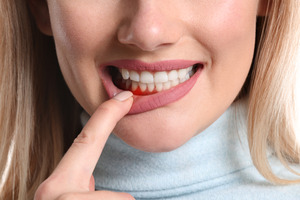
Sleep apnea has been linked to a variety of health issues, and you might be surprised to learn that gum disease is among them. Researchers have found that sleep apnea patients are more likely to show symptoms of moderate or severe periodontitis, which is the advanced form of gum disease. How are these two conditions linked, and what steps can you take to address them both? The following post has the answers.
What are Sleep Apnea and Gum Disease?
Sleep apnea is a prominent sleep disorder that affects as many as 18 million Americans. If you have sleep apnea, you’ll experience frequent pauses in your breathing while you’re asleep. Each time breathing stops, the body is forced to briefly awaken for air, preventing you from getting quality sleep. As a result, you’ll likely feel more tired than normal during the day, and your overall health will suffer.
Meanwhile, gum disease is an infection of the tissues holding your teeth in place. At first, it starts with mild symptoms like redness, swelling, and bleeding. When left untreated for too long, gum disease can eventually turn into periodontitis, which often directly leads to tooth loss.
The Connection Between Sleep Apnea and Gum Disease
While the relationship between sleep apnea and gum disease is still being studied, many experts believe it has to do with mouth breathing. People who suffer from sleep apnea are more likely to breathe through their mouths in an effort to get more oxygen. This causes saliva to dry out, resulting in a dry mouth. Without the saliva needed to keep your teeth and gums clean, harmful oral bacteria can grow more easily, thus increasing your risk for gum disease and other oral health issues.
How Can You Treat Sleep Apnea and Gum Disease?
You’ll want to have sleep apnea and gum disease treated as soon as possible; leaving either condition alone for too long could lead to even bigger problems. For sleep apnea, you’ll want to find a dentist who is trained in identifying and treating sleep disorders. They can help you manage your symptoms with a customized oral appliance. Said appliance will slightly move your lower jaw forward to prevent the soft tissues in your mouth and throat from collapsing and blocking your airway.
As for gum disease, good oral hygiene and regular dental cleanings are sometimes all you need to reverse it. But if your gum disease has already reached the periodontitis stage, you’ll likely need your dentist’s help to keep the infection under control. Usually, this involves a deep cleaning procedure where plaque and tartar are removed from around and below your gum line.
Both sleep apnea and gum disease can have dire consequences if you ignore them. It’s important to keep an eye out for any potential warning signs of a sleep disorder or a periodontal infection so that you can seek help from a professional as soon as possible. Take the initiative in protecting your smile and getting a good night’s rest!
About the Author
Dr. Gary Radz discovered oral sleep appliances over a decade ago when he needed an alternative to CPAP therapy to treat his own sleep apnea. Today at Downtown Denver Sleep Solutions, he uses oral appliance therapy to help his patients overcome their sleep disorders. To schedule a consultation with Dr. Radz, visit his website or call (303) 377-5337.